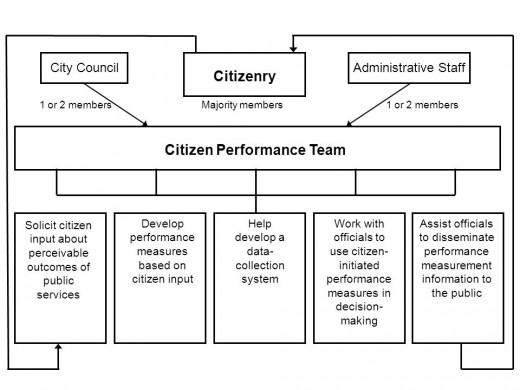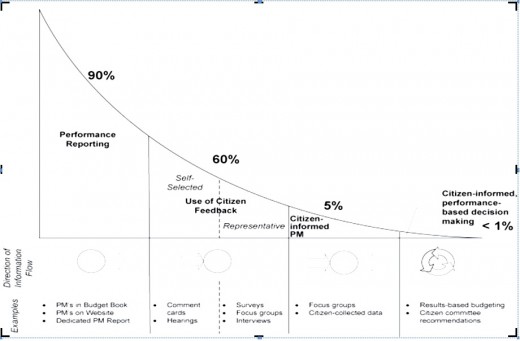Performance Standards and Government Effectiveness
Hypothesis
Governments who implement performance standards increase their effectiveness and efficiency. Further, citizen involvement in governmental performance evaluations improves the process and quality of services.
Citizen Involvement in Government Decision Making

Governments Lack Performance Standards
Many governmental entities lack measures and standards for performance resulting in inefficiencies and a lack of effectiveness. Public education has undergone scrutiny. School effectiveness has been the subject of research. Critics say that even the research methods themselves for determining whether or not a school is effective are far too varied and not subject to standardization (Luyten, Visscher & Witziers). The idea that government employees and teachers should also be held to performance measures and standards has been resisted.
In many cases, performance standards developed by the government agencies themselves have not involved citizen participation. Government at all levels can benefit from implementing standard performance measures particularly if citizen involvement is incorporated.
Quality and Performance Evaluations
Methods for improving government performance have been introduced from the private sector. Total Quality Management (TQM) is one of the more well-known approaches in the private sector that governmental agencies have incorporated into their practices. “Quality is defined by customers involved in an organization’s supply chain as the wish to see an organization work efficiently and effectively, at minimum cost. To be successful, quality must be integrated into the business. This is achieved through an understanding of the vision, goals and aims of the organization” (McAdam & Saulters).
The US Office of Personnel Management defines performance standards as, “A management-approved expression of the performance threshold(s), requirement(s), or expectation(s) that must be met to be appraised at a particular level of performance.” Even if citizens are involved in performance standards, management must ultimately approve them. The performance thresholds must be appraised. Administrators alone should not conduct the appraisal. Further, “A fully successful (or equivalent) standard must be established for each critical element and included in the employee performance plan.” Governmental employees are not immune from having their performance being evaluated. “If other levels of performance are used by the appraisal program, writing standards for those levels and including them in the performance plan is not required but is encouraged so that employees will know what they have to do to meet standards higher than fully successful.” The agency is only as good as its employees.
There are four key components of performance standards: (1) quality, (2) quantity (3) timeliness, and (4) cost-effectiveness. We will define efficiency as “functioning or producing effectively and with the least waste of effort; competent.” Citizens should expect competent governmental employees.
Effectiveness can be defined as, “Successful in producing a desired or intended result.” Encouraging government to be both effective and efficient and further, measuring effectiveness and efficiency to evaluate performance are greatly desired.
Interviews, Focus Groups and Surveys
The methodology used in this study employs secondary data from established research and commentary on the subject. This involves qualitative data through interviews, focus groups, and surveys. Data was quantified into measurable outputs and outcomes. A research project by the Government Finance Officers Association (GFOA) was conducted to learn more about the performance measurement and management practices of governments in the United States and Canada (Kinney). Survey and telephone interview results are shown in Figure 1.
Figure 1: Citizen Informed Performance Based Decision Making

Government Survey Results
Survey results suggest that some governments have moved from simply developing performance measures to routinely incorporating measurement information into planning, budgeting, operational, and policy-making processes (Kinney). The survey was conducted using a city population size of equal to or greater than twenty five thousand. 1284 governments were represented. 60% reported that performance measures were being used. Two specific questions relating to citizen involvement included: (1) Do you have a means of soliciting citizen feedback? (2) Are citizens involved in developing performance measures? The results show that most use citizen feedback. Only about 5% use citizen-informed performance measures. Still fewer than 1% use citizen-informed performance-based decision making. As the level of citizen involvement increases, the number of agencies who incorporate citizen committee recommendations decreases. Does the efficiency and effectiveness increase with citizen involvement?
Examples of Citizen-Based Performance Reviews
Citizen involvement is a key element in improving efficiency and effectiveness. “High levels of people-satisfaction lead to improved customer satisfaction which, in turn, delivers a range of improved business results” (McAdam & Saulters). There is a parallel between customer satisfaction and citizen satisfaction. Can government operate more like a business to achieve improved results? Is “customer satisfaction” applicable to public agencies? Does citizen satisfaction increase with participation in governmental decisions?
According to Holzer & Kim, “Citizen participation efforts facilitate citizens’ input into the process of reaching decisions, increasing the likelihood that the quality of government service provision will be more responsive to their needs.” Training and education for public administrators is encouraged to understand citizen-influenced performance measurement.
Further, the Alfred P. Sloan Foundation centers its ideology on and promotes citizen-based performance measurement (Greenwood). Their focus area is “Management by Results” which quantifies inputs, outputs, and outcomes for delivering government services effectively and using resources efficiently.
According to Berman, “The public is described as the ultimate stakeholder and consumer of government services, [as well as] taxpayers and the electors of its government leaders.” Governments collect data on a variety of quantifiable measures such as revenues and expenses, number of applicants being served in a given program, tons of refuse collected, and miles of lanes paved. Regular reporting of those quantifiable measures is desired and in particular, public participation is encouraged through hearings in order to achieve more transparency and satisfaction. ”The public often assesses local government performance differently from government’s typical measures.” Focus groups involving citizens should be setup and government officials should pay close attention to their opinions. “Measurements and reports alone are not sufficient and performance improvement should be the goal.”
Perhaps the strongest case for citizen-based performance measures comes from the analysis and results of a strategic plan for the city of Worcester using Computerized Neighborhood Environment Tracking (ComNET). The study indicates that citizen-based performance measurement and reporting have, “led to more effective and efficient delivery of municipal services and a more involved, satisfied, and better-informed citizenry.” ComNET is a set of surveys that enable residents and officials to identify and document specific problems affecting residents’ quality of life such as potholes, faded crosswalks, abandoned vehicles, illegal dumping, and overgrown vegetation. This inventory serves as a baseline for gauging whether neighborhoods are improving or declining. “Seven thousand abandoned vehicles were removed from the streets, and quicker response time saved $275,000” (Schaefer). These are just two of the more dramatic results that the city was able to achieve. What are some specific methods public administrators need to implement in order to close the gap between citizen involvement and government performance?
According to Greenwood, “The gap between community indicators and government performance measurement can also be bridged by connecting the indicators that reflect a high-level view of the world and the performance measures that reflect a lower-level view by means of logic chains.” The goal is to link government performance measures to community indicators and allow them to be measured and reported by the public. This would require a legislative mandate and the funds to support it.
Limitations of Measuring Citizen Satisfaction
Involving citizens in performance measures for government is a relatively new and evolving process that is not standardized. There exists a tension and gap between theory and practice. Survey data, telephone interviews and focus groups can be costly, time consuming and subjective. Further quantifiable research could be done to study the relationship between government performance standards and citizen satisfaction using correlation analysis or bivariate linear regression.
Benefits of Citizen Satisfaction
Governments can improve efficiency and effectiveness by implementing performance standards. Governments who involve their citizens in the planning and performance of their organization have improved efficiency, effectiveness and customer satisfaction. Citizen-based performance measures and standards is desired for all levels of government.
Involve Citizens When Implementing Performance Measures.
Public managers should involve their citizens in planning, organizing and implementing performance measures. Methods should include focus groups, interviews and surveys. Interview and survey questions should be designed with input from the public. Management should seek out more information on the methods and techniques of successful models. Technology similar to ComNET should be used to collect and analyze data. Decisions should be based on the analysis of the data with full disclosure and transparency to the public; don’t just report the good news. Administrators should find out what other jurisdictions are implementing and share best practices. Consider input from other professionals, non-profit organizations and community organizations. Narrow the scope and provide more focused performance measures.
Reference
Berman, B.J. (2008). Involving the Public in Measuring and Reporting Local Government Performance. National Civic Review. Wiley Periodicals, INC.: 3-10.
Greenwood, T. (2008). Bridging the Divide Between Community Indicators and Government Performance Measurement. National Civic Review. Wiley Periodicals, INC.: 55-59.
Greenwood, T. (2008). The Alfred P. Sloan Foundation’s Program to Make Municipal Governments More Responsive to Their Citizens. National Civic Review. Wiley Periodicals, INC.: 11-12.
Holzer, M. & Kim, Y. (2008). Educating Public Officials and Managers: A University Experience. National Civic Review. Wiley Periodicals, INC.: 21-28.
Kinney, A. (2008). Current Approaches to Citizen Involvement in Performance
Measurement and Questions They Raise. National Civic Review. Wiley Periodicals, INC.: 46-54.
Luyten, H., Visscher, A., & Witziers, B. (2004). School Effectiveness Research: From a review of the criticism to recommendations for further development. School Effectiveness and School Improvement. Vol. 16, No. 3, pp. 249 – 279.
Mc Adams, R. & Saulters, R. (2000). Quality measurement frameworks in the public sector. Total Quality Management. Carfax Publishing. Vol. 11. No. 4/5&6: S652-S656.
Schaeffer, R. (2008). Starting performance measurement from outside government in Worcester. National Civic Review. Wiley Periodicals, INC.: 41-45.
US Office of Personnel Management. Developing performance standards. Retrieved from: http://www.opm.gov/perform/articles/118.asp








